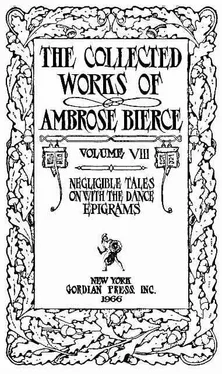Ambrose Bierce - The Collected Works of Ambrose Bierce, Volume 8 / Epigrams, On With the Dance, Negligible Tales
Здесь есть возможность читать онлайн «Ambrose Bierce - The Collected Works of Ambrose Bierce, Volume 8 / Epigrams, On With the Dance, Negligible Tales» весь текст электронной книги совершенно бесплатно (целиком полную версию без сокращений). В некоторых случаях можно слушать аудио, скачать через торрент в формате fb2 и присутствует краткое содержание. Жанр: Классическая проза, на английском языке. Описание произведения, (предисловие) а так же отзывы посетителей доступны на портале библиотеки ЛибКат.
- Название:The Collected Works of Ambrose Bierce, Volume 8 / Epigrams, On With the Dance, Negligible Tales
- Автор:
- Жанр:
- Год:неизвестен
- ISBN:нет данных
- Рейтинг книги:4 / 5. Голосов: 1
-
Избранное:Добавить в избранное
- Отзывы:
-
Ваша оценка:
- 80
- 1
- 2
- 3
- 4
- 5
The Collected Works of Ambrose Bierce, Volume 8 / Epigrams, On With the Dance, Negligible Tales: краткое содержание, описание и аннотация
Предлагаем к чтению аннотацию, описание, краткое содержание или предисловие (зависит от того, что написал сам автор книги «The Collected Works of Ambrose Bierce, Volume 8 / Epigrams, On With the Dance, Negligible Tales»). Если вы не нашли необходимую информацию о книге — напишите в комментариях, мы постараемся отыскать её.
The Collected Works of Ambrose Bierce, Volume 8 / Epigrams, On With the Dance, Negligible Tales — читать онлайн бесплатно полную книгу (весь текст) целиком
Ниже представлен текст книги, разбитый по страницам. Система сохранения места последней прочитанной страницы, позволяет с удобством читать онлайн бесплатно книгу «The Collected Works of Ambrose Bierce, Volume 8 / Epigrams, On With the Dance, Negligible Tales», без необходимости каждый раз заново искать на чём Вы остановились. Поставьте закладку, и сможете в любой момент перейти на страницу, на которой закончили чтение.
Интервал:
Закладка:
When modesty's last rag has been discarded, the girls as if suddenly abashed at their own audacity, fly like startled fawns from the room, leaving their patrons to make a settlement with conscience and arrange the terms upon which that monitor will consent to the performance of the rest of the dance. For the dance proper—or improper—is now about to begin. If the first part seemed somewhat tropical, comparison with what follows will acquit it of that demerit. The combinations of the dance are infinitely varied, and so long as willing witnesses remain—which, in simple justice to manly fortitude it should be added, is a good while—so long will the "Chon Nookee" present a new and unexpected phase, but it is thought expedient that no more of them be presented here, and if the reader has done me the honor to have enough of it, we will pass to the consideration of another class of dances.
Of this class those most in favor are the Fan and Umbrella dances, performed, usually, by young girls trained almost from infancy. The Japanese are passionately fond of these beautiful exhibitions of grace, and no manner of festivity is satisfactorily celebrated without them. The musicians, all girls, commonly six or eight in number, play on the guitar, a small ivory wand being used, instead of the fingers, to strike the strings. The dancer, a girl of some thirteen years, is elaborately habited as a page. Confined by the closely folded robe as by fetters, the feet and legs are not much used, the feet, indeed, never leaving the floor. Time is marked by undulations of the body, waving the arms, and deft manipulation of the fan. The supple figure bends and sways like a reed in the wind, advances and recedes, one movement succeeding another by transitions singularly graceful, the arms describing innumerable curves, and the fan so skilfully handled as to seem instinct with a life and liberty of its own. Nothing more pure, more devoid of evil suggestion, can be imagined. It is a sad fact that the poor children trained to the execution of this harmless and pleasing dance are destined, in their riper years, to give their charms and graces to the service of the devil in the 'Chon Nookee'. The umbrella dance is similar to the one just described, the main difference being the use of a small, gaily colored umbrella in place of the fan.
Crossing from Japan to China, the Prude will find a condition of things which, for iron severity of morals, is perhaps unparalleled—no dancing whatever, by either profligate or virtuous women. To whatever original cause we may attribute this peculiarity, it seems eternal, for the women of the upper classes have an ineradicable habit of so mutilating their feet that even the polite and comparatively harmless accomplishment of walking is beyond their power, those of the lower orders have not sense enough to dance, and that men should dance alone is a proposition of such free and forthright idiocy as to be but obscurely conceivable to any understanding not having the gift of maniacal inspiration, or the normal advantage of original incapacity. Altogether, we may rightly consider China the heaven appointed habitat of people who dislike the dance.
In Siam, what little is known of dancing is confined to the people of Laos. The women are meek eyed, spiritless creatures, crushed under the heavy domination of the stronger sex. Naturally, their music and dancing are of a plaintive, almost doleful character, not without a certain cloying sweetness, however. The dancing is as graceful as the pudgy little bodies of the women are capable of achieving—a little more pleasing than the capering of a butcher's block, but not quite so much so as that of a wash tub. Its greatest merit is the steely rigor of its decorum. The dancers, however, like ourselves, are a shade less appallingly proper off the floor than on it.
In no part of the world, probably, is the condition of women more consummately deplorable than in India, and, in consequence, nowhere than in the dances of that country is manifested a more simple unconsciousness or frank disregard of decency. As by nature, and according to the light that is in him, the Hindu is indolent and licentious, so, in accurately matching degree, are the dancing girls innocent of morality, and uninfected with shame. It would be difficult, more keenly to insult a respectable Hindu woman than to accuse her of having danced, while the man who should affect the society of the females justly so charged would incur the lasting detestation of his race. The dancing girls are of two orders of infamy—those who serve in the temples, and are hence called Devo Dasi, slaves of the gods, and the Nautch girls, who dance in a secular sort for hire. Frequently a mother will make a vow to dedicate her unborn babe, if it have the obedience to be a girl, to the service of some particular god, in this way, and by the daughters born to themselves, are the ranks of the Devo Dasi recruited. The sons of these miserable creatures are taught to play upon musical instruments for their mothers and sisters to dance by. As the ordinary Hindu woman is careless about the exposure of her charms, so these dancers take intelligent and mischievous advantage of the social situation by immodestly concealing their own. The Devo Dasi actually go to the length of wearing clothes! Each temple has a band of eight or ten of these girls, who celebrate their saltatory rites morning and evening. Advancing at the head of the religious procession, they move themselves in an easy and graceful manner, with gradual transition to a more sensuous and voluptuous motion, suiting their action to the religious frame of mind of the devout until their well-rounded limbs and lithe figures express a degree of piety consonant with the purpose of the particular occasion. They attend all public ceremonies and festivals, executing their audacious dances impartially for gods and men.
The Nautch girls are purchased in infancy, and as carefully trained in their wordly way as the Devo Dasi for the diviner function, being about equally depraved. All the large cities contain full sets of these girls, with attendant musicians, ready for hire at festivals of any kind, and by leaving orders parties are served at their residences with fidelity and dispatch. Commonly they dance two at a time, but frequently some wealthy gentleman will secure the services of a hundred or more to assist him through the day without resorting to questionable expedients of time-killing. Their dances require strict attention, from the circumstance that their feet—like those of the immortal equestrienne of Banbury Cross—are hung with small bells, which must be made to sound in concert with the notes of the musicians. In attitude and gesture they are almost as bad as their pious sisters of the temples. The endeavor is to express the passions of love, hope, jealousy, despair, etc, and they eke out this mimicry with chanted songs in every way worthy of the movements of which they are the explanatory notes. These are the only women in Hindustan whom it is thought worth while to teach to read and write. If they would but make as noble use of their intellectual as they do of their physical education, they might perhaps produce books as moral as The Dance of Death .
In Persia and Asia Minor, the dances and dancers are nearly alike. In both countries the Georgian and Circassian slaves who have been taught the art of pleasing, are bought by the wealthy for their amusement and that of their wives and concubines. Some of the performances are pure in motive and modest in execution, but most of them are interesting otherwise. The beautiful young Circassian slave, clad in loose robes of diaphanous texture, takes position, castanets in hand, on a square rug, and to the music of a kind of violin goes through the figures of her dance, her whiteness giving her an added indelicacy which the European spectator misses in the capering of her berry brown sisters in sin of other climes.
Читать дальшеИнтервал:
Закладка:
Похожие книги на «The Collected Works of Ambrose Bierce, Volume 8 / Epigrams, On With the Dance, Negligible Tales»
Представляем Вашему вниманию похожие книги на «The Collected Works of Ambrose Bierce, Volume 8 / Epigrams, On With the Dance, Negligible Tales» списком для выбора. Мы отобрали схожую по названию и смыслу литературу в надежде предоставить читателям больше вариантов отыскать новые, интересные, ещё непрочитанные произведения.
Обсуждение, отзывы о книге «The Collected Works of Ambrose Bierce, Volume 8 / Epigrams, On With the Dance, Negligible Tales» и просто собственные мнения читателей. Оставьте ваши комментарии, напишите, что Вы думаете о произведении, его смысле или главных героях. Укажите что конкретно понравилось, а что нет, и почему Вы так считаете.




